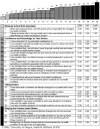Development of the Patient Activation Measure (PAM): conceptualizing and measuring activation in patients and consumers
- PMID: 15230939
- PMCID: PMC1361049
- DOI: 10.1111/j.1475-6773.2004.00269.x
Development of the Patient Activation Measure (PAM): conceptualizing and measuring activation in patients and consumers
Abstract
Background: Controlling costs and achieving health care quality improvements require the participation of activated and informed consumers and patients.
Objectives: We describe a process for conceptualizing and operationalizing what it means to be "activated" and delineate the process we used to develop a measure for assessing "activation," and the psychometric properties of that measure.
Methods: We used the convergence of the findings from a national expert consensus panel and patient focus groups to define the concept and identify the domains of activation. These domains were operationalized by constructing a large item pool. Items were pilot-tested and initial psychometric analysis performed using Rasch methodology. The third stage refined and extended the measure. The fourth stage used a national probability sample to assess the measure's psychometric performance overall and within different subpopulations.
Study sample: Convenience samples of patients with and without chronic illness, and a national probability sample (N=1,515) are included at different stages in the research.
Conclusions: The Patient Activation Measure is a valid, highly reliable, unidimensional, probabilistic Guttman-like scale that reflects a developmental model of activation. Activation appears to involve four stages: (1) believing the patient role is important, (2) having the confidence and knowledge necessary to take action, (3) actually taking action to maintain and improve one's health, and (4) staying the course even under stress. The measure has good psychometric properties indicating that it can be used at the individual patient level to tailor intervention and assess changes.
Figures
References
-
- Andrich D. A Rating Formulation for Ordered Response Categories. Psychometrica. 1978;43(4):561–73.
-
- Bandura A. Self-efficacy Mechanism in Physiological Activation and Health-Promoting Behavior. In: Madden J, Matthysse S, Barchas J, editors. Adaption, Learning and Affect. New York: Raven Press; 1991. pp. 226–69.
-
- Bodenheimer T, Lorig K, Holman H, Grumbach K. Patient Self-Management of Chronic Disease in Primary Care. Journal of the American Medical Association. 2002;288(19):2469–75. - PubMed
-
- Bond T, Fox C. Applying the Rasch Model: Fundamental Measurement in the Human Sciences. Mahwah, NJ: Erlbaum; 2001.
-
- Day J, Bodmer CW, Dunn OM. Development of a Questionnaire Identifying Factors Responsible for Successful Self-management of Insulin-Treated Diabetes. Diabetic Medicine. 1996;13(6):564–73. - PubMed
Publication types
MeSH terms
LinkOut - more resources
Full Text Sources
Medical
Miscellaneous




